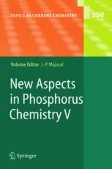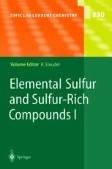Search
Search Results
-
Evidences for Polaron Formation in Cuprates
It is widely believed that the essential physics of high temperature superconducting copper oxides are governed by the properties of their...
-
Phosphinidenes
Of the low-valent organophosphorus compounds phosphinidenes occupy a special place. In ‘free’ phosphinidenes the phosphorus atom carries a single...
-
Asymmetric Processes Catalyzed by Chiral (Salen)Metal Complexes
A wide variety of highly selective asymmetric reactions catalyzed by chiral (salen)metal complexes have been disclosed over the past decade. Salen...
-
Sparteine as a Chiral Ligand for Asymmetric Catalysis
While the use of stoichiometric amounts of sparteine and related ligands in various asymmetric reactions often lead to highly enantioselective...
-
The Zintl–Klemm Concept Applied to Cations in Oxides. II. The Structures of Silicates
The structures of ternary and quaternary silicates are revisited on the basis of the Zintl–Klemm concept and the Pearson's generalised octet rule....
-
Probing Hydrogen Bonding in Solids Using Solid State NMR Spectroscopy
Solid state nuclear magnetic resonance (NMR) spectroscopy is a powerful and versatile technique for probing structural and dynamic properties of...
-
Polarons and Transport in DNA
It has been widely considered that the wavefunction of an extra electron or hole on the base stack of a DNA molecule is confined to a single site,...
-
Heat Capacity Studies of Spin Crossover Systems
As the spin crossover phenomena occurring in Oh symmetry involve a transfer of electrons between the eg and t2g orbitals, the metal-to-ligand bond...
-
Time-Resolved Relaxation Studies of Spin Crossover Systems in Solution
This chapter focuses on the kinetics of spin-state relaxation, primarily in iron(II) complexes in solution. Initial work carried out during the 1970s...
-
Density Functional Theory Calculations for Spin Crossover Complexes
Density functional theory (DFT) provides a theoretical framework for efficient and fairly accurate calculations of the electronic...
-
Octahedral Zirconium Complexes as Polymerization Catalysts
The synthesis and X-ray structure of various octahedral zirconium complexes and their catalytic properties in the polymerization of α-olefins are...
-
The Rise of Organophosphorus Derivatives in π-Conjugated Materials Chemistry
This chapter concerns the synthesis and properties of π-conjugated oligomers and polymers containing phosphorus moieties, an area of increasing...
-
Carboselenothioic and Carbodiselenoic Acid Derivatives and Related Compounds
In this chapter we consider derivatives of carboselenothioic and carbodiselenoic acids, and compounds related to them. Ammonium salts and inner salts...
-
Biologically Produced Sulfur
Sulfur compound oxidizing bacteria Sulfur compound oxidizing bacteria produce sulfur as an intermediate in the...
-
Hydrozirconation and Its Applications
Next to hydroboration and hydrostannylation, hydrozirconation is among the few general methods available for the stoichiometric conversion of readily...
-
Ligand Field Theoretical Considerations
The phenomenon of the thermal spin transition, as observed for octahedral transition metal complexes having a d...
-
Special Classes of Iron(II) Azole Spin Crossover Compounds
In this chapter, selected results obtained so far on Fe(II) spin crossover compounds of 1,2,4-triazole, isoxazole and tetrazole derivatives are...
-
Progress in the Asymmetric Synthesis of 1,2-Diamines from Azomethine Compounds
Recent advances in the preparation of optically pure 1,2-diamines by stereoselective addition reactions to azomethine compounds (imines, iminium...
-
Intraband Spectroscopy and Semiconductor Nanocrystals
This chapter reviews intraband spectroscopy as it has been applied to semiconductor nanocrystals synthesized by colloid methods.
-
Application of Evolutionary Algorithms to Global Cluster Geometry Optimization
This contribution focuses upon the application of evolutionary algorithms to the nondeterministic polynomial hard problem of global cluster geometry...
